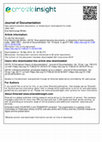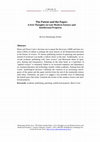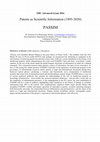Books by Eva Hemmungs Wirtén
In the annals of international copyright history—by and large synonymous with the Berne Union and... more In the annals of international copyright history—by and large synonymous with the Berne Union and the Berne Convention for the Protection of Literary and Artistic Works from 1886—translation occupies a contested space. From the end of the nineteenth century until today, translation has highlighted the multifaceted legal dimensions associated with the inherent instability of cultural works, the proliferation of authorship, and the tensions between major and minor languages, producers and users, import and export. Set in the first era of international copyright relations, between 1886 and 1971, Cosmopolitan Copyright tells a story of international power relations in the making, practices of cultural transformation, the changing face of global governance, and the limits and possibilities of authorship vis-à-vis the law.
Articles/Essays by Eva Hemmungs Wirtén

Journal of Material Culture, 2021
This article is about an everyday paper object: an envelope. However, as opposed to most other fl... more This article is about an everyday paper object: an envelope. However, as opposed to most other flat paper containers, the enveloppe Soleau can only be bought from L'Institut national de la propriété industrielle (INPI) in Paris. At the cost of €15 you get a perforated, double-compartment envelope allowing you to constitute proof of creation and assign a precise date to your idea or project. But the enveloppe Soleau is something much more than just a simple and cheap way by which you can prove priority in any creative domain. It is a material footprint anchored to centuries of practices associated with disclosure and secrecy, a gateway into the infrastructure of the intellectual property system and its complicated relationship to the forms of knowledge it purports to hold. The purpose of this article is to consider the making of the enveloppe Soleau as a bureaucratic document, a material device performing a particular kind of legal paperwork. In four different vignettes, the article tracks the material becoming of the enveloppe Soleau as an evidentiary receptacle, beginning by going back to early modern practices of secrecy and priority, continuing with its consolidation in two patents (from 1910 and 1911) to the inventor Eugène Soleau (1852-1929), and ending up, in 2016, dematerialized in the e-Soleau. As a bureaucratic document, the enveloppe Soleau shows just how much work a mundane paper object can perform, navigating a particular materiality (a patented double envelope); formalized processes of proof (where perforations have legal significance); the practices of double archiving (in an institution and with the individual) and strict temporal limitations (a decade). Ultimately, the enveloppe Soleau travels between the material and immaterial, between private and public, between secrecy and disclosure, but also between what we perceive of as the outside and inside of the intellectual property system.

Journal of Material Culture, 2021
This article is about an everyday paper object: an envelope. However, as opposed to most other fl... more This article is about an everyday paper object: an envelope. However, as opposed to most other flat paper containers, the enveloppe Soleau can only be bought from L'Institut national de la propriété industrielle (INPI) in Paris. At the cost of €15 you get a perforated, double-compartment envelope allowing you to constitute proof of creation and assign a precise date to your idea or project. But the enveloppe Soleau is something much more than just a simple and cheap way by which you can prove priority in any creative domain. It is a material footprint anchored to centuries of practices associated with disclosure and secrecy, a gateway into the infrastructure of the intellectual property system and its complicated relationship to the forms of knowledge it purports to hold. The purpose of this article is to consider the making of the enveloppe Soleau as a bureaucratic document, a material device performing a particular kind of legal paperwork. In four different vignettes, the article tracks the material becoming of the enveloppe Soleau as an evidentiary receptacle, beginning by going back to early modern practices of secrecy and priority, continuing with its consolidation in two patents (from 1910 and 1911) to the inventor Eugène Soleau (1852-1929), and ending up, in 2016, dematerialized in the e-Soleau. As a bureaucratic document, the enveloppe Soleau shows just how much work a mundane paper object can perform, navigating a particular materiality (a patented double envelope); formalized processes of proof (where perforations have legal significance); the practices of double archiving (in an institution and with the individual) and strict temporal limitations (a decade). Ultimately, the enveloppe Soleau travels between the material and immaterial, between private and public, between secrecy and disclosure, but also between what we perceive of as the outside and inside of the intellectual property system.

Journal of Documentation, 2019
Abstract
Purpose – The purpose of this paper is to show how the documentation movement associated... more Abstract
Purpose – The purpose of this paper is to show how the documentation movement associated with the utopian thinkers Paul Otlet and Henri La Fontaine relied on patent offices as well as the documents most
closely associated with this institutional setting – the patents themselves – as central to the formation of the document category. The main argument is that patents not only were subjected to and helped construct, but
also in fact engineered the development of technoscientific order during 1895–1937.
Design/methodology/approach – The paper draws on an interdisciplinary approach to intellectual property, document theory and insights from media archeology. Focused on the historical period 1895–1937,
this study allows for an analysis that encapsulates and accounts for change in a number of comparative areas, moving from bibliography to documentation and from scientific to technoscientific order. Primary sources include Paul Otlet’s own writings, relevant contemporary sources from the French documentation movement and the Congrès Mondial de la documentation universelle in 1937.
Findings – By understanding patent offices and patents as main drivers behind those processes of sorting and classification that constitute technoscientific order, this explorative paper provides a new analytical
framework for the study of intellectual property in relation to the history of information and documentation. It argues that the idea of the document may serve to rethink the role of the patent in technoscience, offering
suggestions for new and underexplored venues of research in the nexus of several overlapping research fields, from law to information studies.
Originality/value – Debates over the legitimacy and rationale of intellectual property have raged for many years without signs of abating. Universities, research centers, policy makers, editors and scholars, research
funders, governments, libraries and archives all have things to say on the legitimacy of the patent system, its relation to innovation and the appropriate role of intellectual property in research and science, milieus that are of central importance in the knowledge-based economy. The value of this paper lies in proposing a new way to approach patents that could show a way out of the current analytical gridlock of either/or that for
many years has earmarked the “openness-enclosure” dichotomy. The combination of intellectual property scholarship and documentation theory provides important new insight into the historical networks and
processes by which patents and documents have consolidated and converged during the twentieth century.

Biographies of scientists occupy a liminal space, highly popular with general readers but questio... more Biographies of scientists occupy a liminal space, highly popular with general readers but questioned in academia. Nonetheless, in recent years, historians of science have not only embraced the genre with more enthusiasm and less guilt, they have also turned to the metabiography in order to renew the study and story of scientists' roles. This essay focuses on Marie Curie, the world's most famous female scientist, in order to unpack some of the theoretical and methodological claims of the science biography, and especially to address the sexing mechanisms at play in the construction of the biographical subject. Pierre Curie (1923), Marie's biography of her husband Pierre, paid tribute to her dead husband and collaborator, but also allowed Curie a legitimate outlet to construct her own persona and legacy. Categories such as personhood, person, and persona are not only central to the biography genre but also are essential to the sense of self and self-fashioning of scientists. Looking at how Marie Curie negotiated these categories in Pierre Curie not only gives new insight into Curie's self-fashioning strategies but may also shed some light on the more general analytical lacunae of the science biography.

Marie and Pierre Curie's decision not to patent the discovery (1898) and later isolation (1902) o... more Marie and Pierre Curie's decision not to patent the discovery (1898) and later isolation (1902) of radium is perhaps the most famous of all disinterested decisions in the history of science. To choose publishing instead of patenting and openness instead of enclosure was hardly a radical choice at the time. Traditionally, we associate academic publishing with " pure science " and Mertonian ideals of openness , sharing and transparency. Patenting on the other hand, as a byproduct of " applied science " is intimately linked to an increased emphasis and dependency on commercialization and technology transfer within academia. Starting from the Curies' mythological decision I delineate the contours of an increasing convergence of the patent and the paper (article) from the end of the nineteenth-century until today. Ultimately, my goal is to suggest a few possible ways of addressing the hybrid space that today constitute the terrain of late modern science and intellectual property.
Cutting Across Media: Appropriation Art, Interventionist Collage, and Copyright Law, 2011
Blackwell Companion to the History of the Book, 2007
PASSIM (2016 ERC Advanced Grant) by Eva Hemmungs Wirtén
Although legal historians and humanities scholars have studied patent law and its histories beyon... more Although legal historians and humanities scholars have studied patent law and its histories beyond their economic effects, it is surprising that they have devoted less attention to their military entang-lements. The workshop welcomes papers on patents, relating to the theme of ‘war and peace’. In this sense, patents are understood as both legal documents and property rights, and conceptualised in a variety of disciplinary ways, ranging from legal tools to secure economic monopolies, to ‘weapons’ protecting national interests. In so doing, the workshop aims to explore patents as devices that create and redistribute power, and as active protagonists fuelling and constituting so-called “patent wars.”

PROPOSAL SUMMARY (2000 characters, with spaces) " History will remember Barack Obama as the great... more PROPOSAL SUMMARY (2000 characters, with spaces) " History will remember Barack Obama as the great Slayer of Patent Trolls. " The headline from the 2014 March 20 issue of Wired credits POTUS with, perhaps, an unexpected feat. Referring to companies in the sole business of enforcing patents beyond their actual value, trolls are a recent installment in the history of an intellectual property whose ubiquitousness the Latin word PASSIM (" here and there, everywhere ") neatly captures. In the eye of the storm stands the patent bargain: disclosure of information in return for a limited monopoly. This contractual moment makes patents a source of information, the basis of new innovation. Or does it? By posing this simple question, PASSIM's bold take on the legitimacy of intellectual property in the governance of informational resources follow patents as legal and informational documents during three historical " patent phases, " producing a visionary and theoretically savvy interpretation of intellectual property that stems from its humanities-based and interdisciplinary project design. PASSIM shows a way out of current analytical gridlocks that earmark the understanding of the role of intellectual property in knowledge infrastructures—most notably the enclosure/openness dichotomy—and provides a fresh take on the complexity of informational processes. A key steppingstone in the PI's career, her own contribution to PASSIM will be a work of synthesis, highlighting major tendencies in the history of patents as scientific information from 1895 to the present. Four complementary empirical studies target specific themes that strengthen PASSIM's validity and impact: questions of copyrights in patents, scientists' patenting strategies both historically and today, the relationship between bibliometrics and patentometrics, and the status of the patent as a legal and informational document. Outputs include workshops, articles, monographs, policy papers and documentation of the project's experiences with interdisciplinary self-reflexivity.








Uploads
Books by Eva Hemmungs Wirtén
Articles/Essays by Eva Hemmungs Wirtén
Purpose – The purpose of this paper is to show how the documentation movement associated with the utopian thinkers Paul Otlet and Henri La Fontaine relied on patent offices as well as the documents most
closely associated with this institutional setting – the patents themselves – as central to the formation of the document category. The main argument is that patents not only were subjected to and helped construct, but
also in fact engineered the development of technoscientific order during 1895–1937.
Design/methodology/approach – The paper draws on an interdisciplinary approach to intellectual property, document theory and insights from media archeology. Focused on the historical period 1895–1937,
this study allows for an analysis that encapsulates and accounts for change in a number of comparative areas, moving from bibliography to documentation and from scientific to technoscientific order. Primary sources include Paul Otlet’s own writings, relevant contemporary sources from the French documentation movement and the Congrès Mondial de la documentation universelle in 1937.
Findings – By understanding patent offices and patents as main drivers behind those processes of sorting and classification that constitute technoscientific order, this explorative paper provides a new analytical
framework for the study of intellectual property in relation to the history of information and documentation. It argues that the idea of the document may serve to rethink the role of the patent in technoscience, offering
suggestions for new and underexplored venues of research in the nexus of several overlapping research fields, from law to information studies.
Originality/value – Debates over the legitimacy and rationale of intellectual property have raged for many years without signs of abating. Universities, research centers, policy makers, editors and scholars, research
funders, governments, libraries and archives all have things to say on the legitimacy of the patent system, its relation to innovation and the appropriate role of intellectual property in research and science, milieus that are of central importance in the knowledge-based economy. The value of this paper lies in proposing a new way to approach patents that could show a way out of the current analytical gridlock of either/or that for
many years has earmarked the “openness-enclosure” dichotomy. The combination of intellectual property scholarship and documentation theory provides important new insight into the historical networks and
processes by which patents and documents have consolidated and converged during the twentieth century.
PASSIM (2016 ERC Advanced Grant) by Eva Hemmungs Wirtén
Purpose – The purpose of this paper is to show how the documentation movement associated with the utopian thinkers Paul Otlet and Henri La Fontaine relied on patent offices as well as the documents most
closely associated with this institutional setting – the patents themselves – as central to the formation of the document category. The main argument is that patents not only were subjected to and helped construct, but
also in fact engineered the development of technoscientific order during 1895–1937.
Design/methodology/approach – The paper draws on an interdisciplinary approach to intellectual property, document theory and insights from media archeology. Focused on the historical period 1895–1937,
this study allows for an analysis that encapsulates and accounts for change in a number of comparative areas, moving from bibliography to documentation and from scientific to technoscientific order. Primary sources include Paul Otlet’s own writings, relevant contemporary sources from the French documentation movement and the Congrès Mondial de la documentation universelle in 1937.
Findings – By understanding patent offices and patents as main drivers behind those processes of sorting and classification that constitute technoscientific order, this explorative paper provides a new analytical
framework for the study of intellectual property in relation to the history of information and documentation. It argues that the idea of the document may serve to rethink the role of the patent in technoscience, offering
suggestions for new and underexplored venues of research in the nexus of several overlapping research fields, from law to information studies.
Originality/value – Debates over the legitimacy and rationale of intellectual property have raged for many years without signs of abating. Universities, research centers, policy makers, editors and scholars, research
funders, governments, libraries and archives all have things to say on the legitimacy of the patent system, its relation to innovation and the appropriate role of intellectual property in research and science, milieus that are of central importance in the knowledge-based economy. The value of this paper lies in proposing a new way to approach patents that could show a way out of the current analytical gridlock of either/or that for
many years has earmarked the “openness-enclosure” dichotomy. The combination of intellectual property scholarship and documentation theory provides important new insight into the historical networks and
processes by which patents and documents have consolidated and converged during the twentieth century.